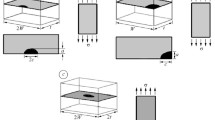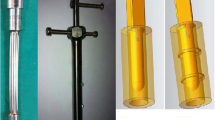We study the structural elements of materials made of bone-cement coupons with various impurities: diethylaminoethyl acrylate, dimethylaminoethyl methacrylate, and diethylaminoethyl methacrylate. With regard for values of the stress intensity factor, we present the characteristics of fracture factors for different times of soaking in simulated body fluid (0; 3; and 6 months) and also for different amounts of impurities in the analyzed material (2–10 wt.%). The data on the stress intensity factors used in the constructed models for different structural elements enable us to analyze possible risks of fracture of these elements in the case where they contain cracklike defects. Moreover, we obtain the values of the critical length of each considered cracklike defect and compute the number of loading cycles in this object that can be useful for the engineering recommendations concerning the tested material and specific structural elements made of this material.
Similar content being viewed by others
Avoid common mistakes on your manuscript.
Bone cements are clinically used in orthopedic surgery for many years for the fixation of artificial joints with encouraging results [1]. Moreover, in [2], the authors studied the effect of incorporation of comonomers containing amine groups on the mechanical and fracture properties of acrylic bone cements. The cements were prepared with either diethylaminoethyl acrylate (DEAEA), or dimethylaminoethyl methacrylate (DMAEM), or diethylaminoethyl methacrylate (DEAEM) as comonomers in the liquid phase. It was discovered that the strength and Young’s modulus decrease as the comonomer content increases in the bending and compressive tests. It was also observed that the fracture toughness is the critical value of the stress intensity factor (SIF) (K Ic ). These properties of cements were also evaluated after soaking the specimens in a simulated body fluid (SBF) for 0, 3 and 6 months.
The application of fracture mechanics is impossible without having reliable criteria for the evaluation of the length of cracklike defects. This issue received much attention. Various phenomena that affect the values of these criteria have been studied. However, the present work has not been completed because, in most countries, there are no standards specifying the criteria of linear and nonlinear fracture mechanics of concrete. The existing theoretical solutions that can be used to estimate the stress distribution ahead of the cracklike defect are very complex and cumbersome. In the engineering practice their application is connected with significant difficulties. Therefore, it is necessary to seek relatively simple, even approximate solutions or models that would simulate the application of criteria in the engineering analyses of the objects that contain defects [3].
Object of Investigation
We study a plate 3 × 10 × 75 mm in sizes made of bone cement and containing cracklike defects in its central part. We consider the case of the defect located exactly in the center of the plate (case I) and the case where eccentric defects are located at small distances from the center of the plate (case II).
By using the values of the stress intensity factors obtained in [2] (see Table 1) and the analytic models of structural elements developed in [4], we propose the calculated values of the critical length of cracklike defects and some models of structural elements containing the defects. On the basis of these models, we present the critical values a fc for a cracklike defect. These critical values a fc are given for three materials. The experimental bone cements were obtained by adding the liquid component to the solid (powder) component at room temperature (25°C). The powder component consisted of Nictone beads, benzoyl peroxide, and barium sulfate (BaSO4) while the liquid component consisted of methyl methacrylate (MMA) (as the base monomer), dimethyl propiathetin and either DEAEA, or DMAEM, or DEAEM in the following amounts: 2, 4, 6, and 10 wt.%; these amounts were incorporated by a partial replacement of MMA in the liquid phase.
The methodology described above was applied in different cases of location of the plate containing a crack. In what follows, we present analytic expressions for the evaluation of the SIF in each model according to which the critical crack length was identified.
Defect I: A plate of finite width containing two-dimensional centered cracks under bending [2, 3] (Fig. 1a):
Defect I: A plate of finite width containing two-dimensional centered cracks under bending (a); Defect II: A plate of finite width containing two-dimensional eccentric cracks under uniform tension (b); 2a is the crack length, t is the thickness of the plate, W is the width of the plate, M is a bending moment, e is the eccentricity of the crack, and σ is tension.
where
Defect II: A plate of finite width containing two-dimensional eccentric cracks under uniform tension [2, 4] (Fig. 1b):
where
Result and Discussion
For the better analysis of the results, we constructed the diagrams of critical length of the cracklike defect depending on the number of months. The analysis of Fig. 2 shows the improved fracture toughness of the material, namely, the length of the cracklike defects increases with the time of soaking of the material. However, this trend is clearly observed only for the DEAEA and DEAEM products. For the third material (DMAEM), the trend is different, which needs more research to be performed for this material.
We now consider the effect of DEAEA and DEAEM additives on the critical length of cracklike defects in bone cement (Fig. 3). The bone cement with 4% DEAEA has the smallest crack-growth resistance and proves to be the most stable material for a 6% content of DEAEM. The following trend should be noted: the changes in the critical crack length in the bone-cement sample are more pronounced after soaking in the SBF for a period of 3–6 months than for 0–3 months of holding. The bone-cement sample with 4% DEAEM is more susceptible to fracture for a period of 0–3 months of soaking and its a fc value also sharply increases in the case of holding for 3–6 months. This occurs both under a load of 20 and under a load of 25 MPa (Fig. 3).
Similar trends are, in principle, observed for all models under consideration. Therefore, in the present paper, we give a detailed analysis of the critical length of cracklike defects for the DEAEA and DEAEM materials.
We now analyze the behavior of defects of different geometries a fc in the studied models. In the second simulated case, the defect is not in the center of the designed elements and is located at a small distance e from the center of the plate. The cases of different values of e varying from 0.05 to 2 mm are discussed. The distances larger than 2 mm were not considered.
The analysis of the results shows that the most dangerous case is observed when the defect is more remote from the design elements. It should be also noted that, in the case of 6 wt.% DEAEA and 6 months of soaking, the fracture toughness is much higher than in all other cases. This fact was observed for DEAEM in both studied cases, i.e., for 4 and 6 wt.% (Fig. 4).
By using the fracture-mechanics approach, we proposed the value of the critical length of cracklike defect for engineering calculations.
The final values of the critical length of defects are shown in Table 2 for each examined case. This table presents the length of the defect in the considered cases after reaching which its growth may occur spontaneously, which is likely to lead to the fracture of the object.
We also calculated the number of loading cycles in these objects. This assists in the engineering recommendations concerning the tested material and specific structural elements made of this material.
In this case, it is supposed that the crack-growth rate diagrams [5] fully describe the crack-growth resistance of the objects. They can be presented in the analytic form by using the well-known Paris equation:
where C and n are the constants of the “material–environment” system. These parameters were calculated in [6]: n = 7.07 and C = 0.0003.
The examples of evaluation of the residual durability of structural elements with defects under cyclic loading in working environments are given. They were obtained on the basis of the well-known formula [3], which provides conditions for the spontaneous fracture of a structural element:
where N fc is the number of loading cycles to fracture of the structural element, and a fc and a 1 are the sizes of the initial cracks.
The computed values of N fc in the second case are quite close to each other and equal to N ≈ 6·106 cycles. In the first case the value of N fc is much higher than in the second case (N ≈ 5 ·109), which suggests that, even despite the higher value of the critical length of the defect, the second case is more unpredictable than the first case because the defect develops much faster.
Conclusions
The present paper gives models for various types of structural elements containing cracklike defects.
On the basis of these models and experimental results, the SIFs were identified and the critical lengths of defects were analyzed. In the considered case, this procedure was performed for structural elements with defects of different geometries. The analysis of the data shows the specific safest defects in the materials. The data accumulated for a fc can be used in the engineering recommendations concerning the tested material and specific structural elements made of this material. As the most important conclusion we can indicate that DEAEM proves to be the best material. It is also worth noting that the second case is more unpredictable than the first case because the defect develops much faster.
References
B. Pascual, M. Gurruchaga, M. P. Ginebra, F. J. Goñi, J. A. Planell, B. Vázquez, J. San Román, and I. Goñi, “Modified acrylic bone cement with high amounts of ethoxytriethyleneglycol methacrylate,” Biomaterials, 20, 453–463 (1999).
A. May-Pata, W. Herrera-Kaoa, J. V. Cauich-Rodrígueza, J. M. Cervantes-Uca, and S. G. Flores-Gallardob, “Comparative study on the mechanical and fracture properties of acrylic bone cements prepared with monomers containing amine groups,” J. Mech. Behav. Biomed. Mater., 6, 95–105 (2012).
V. V. Panasyuk, I. I. Luchko, and I. M. Pan’ko, “Deformation model of fracture of concrete,” Probl. Prochn., No. 2, 18–28 (2003).
I. M. Dmytrakh, L. Tot, O. L. Bilyi, and A. M. Syrotyuk, Serviceability of Materials and Structural Elements with Pointed Stress Concentrators, in: V. V. Panasyuk (editor), Fracture Mechanics and Strength of Materials. A Handbook [in Ukrainian], Vol. 13, Spolom, Lviv (2012).
I. M. Dmytrakh, A. B. Vainman, M. H. Stashchuk, et. al., Reliability and Durability of Structural Elements of the Power-Generating Equipment, in: Fracture Mechanics and Strength of Materials. A Handbook [in Ukrainian], Vol. 7, Akademperiodyka, Kiev (2005).
M. A. Sabino, D. Ajami, D. Salih, N. Nazhat, R. Vargas-Coronado, J. V. Cauich-Rodriguez, and M. P. Ginebra, “Physicochemical, mechanical, and biological properties of bone cements prepared with functionalized methacrylates,” J. Biomater. Appl., 147–161.
Author information
Authors and Affiliations
Corresponding author
Additional information
Published in Fizyko-Khimichna Mekhanika Materialiv, Vol. 53, No. 1, pp. 102–107, January–February, 2017.
Rights and permissions
About this article
Cite this article
Acuña Gonzales, N.A., Bilyi, O.L. & González Sánchez, J.A. Monitoring of the Critical Length of Cracklike Defects in the Bone-Cement Plate with Regard for their Different Geometry. Mater Sci 53, 116–122 (2017). https://doi.org/10.1007/s11003-017-0051-5
Received:
Published:
Issue Date:
DOI: https://doi.org/10.1007/s11003-017-0051-5








